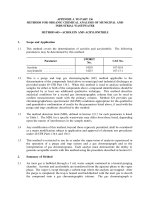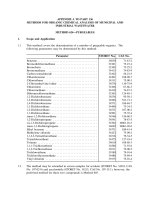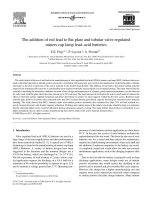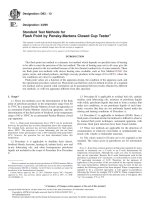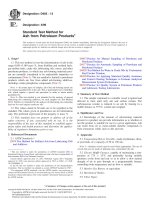ASTM D49-83 (2020) Standard Test Methods of Chemical Analysis of Red Lead
Bạn đang xem bản rút gọn của tài liệu. Xem và tải ngay bản đầy đủ của tài liệu tại đây (95.33 KB, 4 trang )
This international standard was developed in accordance with internationally recognized principles on standardization established in the Decision on Principles for the
Development of International Standards, Guides and Recommendations issued by the World Trade Organization Technical Barriers to Trade (TBT) Committee.
Designation: D49 − 83 (Reapproved 2020)
Standard Test Methods of
Chemical Analysis of Red Lead1
This standard is issued under the fixed designation D49; the number immediately following the designation indicates the year of original
adoption or, in the case of revision, the year of last revision. A number in parentheses indicates the year of last reapproval. A superscript
epsilon (´) indicates an editorial change since the last revision or reapproval.
1. Scope D1301 Test Methods for Chemical Analysis of White Lead
Pigments
1.1 These test methods cover procedures for the chemical
analysis of red lead having the approximate formula Pb3O4 D1959 Test Method for Iodine Value of Drying Oils and
(probably PbO2·2PbO). Fatty Acids (Withdrawn 2006)3
1.2 The values stated in SI units are to be regarded as 3. Treatment of Sample
standard. No other units of measurement are included in this
standard. 3.1 If the pigment is lumpy or not finely ground, grind it to
a fine powder and mix thoroughly. Large samples may be
1.3 This standard does not purport to address all of the thoroughly mixed and a representative portion taken and
safety concerns, if any, associated with its use. It is the powdered if lumpy or not finely ground. The sample in all
responsibility of the user of this standard to establish appro- cases shall be thoroughly mixed before taking portions for
priate safety, health, and environmental practices and deter- analysis. All samples shall be preserved in stoppered bottles or
mine the applicability of regulatory limitations prior to use. containers.
1.4 This international standard was developed in accor- 4. Purity of Reagents
dance with internationally recognized principles on standard-
ization established in the Decision on Principles for the 4.1 Reagent grade chemicals shall be used in all tests.
Development of International Standards, Guides and Recom- Unless otherwise indicated, it is intended that all reagents shall
mendations issued by the World Trade Organization Technical conform to the specifications of the Committee on Analytical
Barriers to Trade (TBT) Committee. Reagents of the American Chemical Society where such
specifications are available.4 Other grades may be used pro-
2. Referenced Documents vided it is first ascertained that the reagent is of sufficiently
high purity to permit its use without lessening the accuracy of
2.1 ASTM Standards:2 the determination.
D50 Test Methods for Chemical Analysis of Yellow, Orange,
4.2 Unless otherwise indicated, references to water shall be
Red, and Brown Pigments Containing Iron and Manga- understood to mean reagent water conforming to Type II of
nese Specification D1193.
D215 Practice for the Chemical Analysis of White Linseed
Oil Paints (Withdrawn 2005)3 5. Moisture
D280 Test Methods for Hygroscopic Moisture (and Other
Matter Volatile Under the Test Conditions) in Pigments 5.1 Determine moisture content with a 2-g specimen in
D1193 Specification for Reagent Water accordance with Method A of Test Methods D280. The
D1208 Test Methods for Common Properties of Certain specimen is dried for 2 h at 105°C. The loss in weight is
Pigments considered as moisture.
1 These test methods are under the jurisdiction of ASTM Committee D01 on 6. Organic Color
Paint and Related Coatings, Materials, and Applications and are the direct
responsibility of Subcommittee D01.31 on Pigment Specifications. 6.1 Boil 2 g of the sample with 25 mL of 95 % ethyl alcohol,
let settle, decant the supernatant liquid; boil the residue with 25
Current edition approved June 1, 2020. Published June 2020. Originally mL of distilled water and decant as before; boil the residue
approved in 1917. Last previous edition approved in 2014 as D49 – 83 (2014). DOI:
10.1520/D0049-83R20. 4 ACS Reagent Chemicals, Specifications and Procedures for Reagents and
Standard-Grade Reference Materials, American Chemical Society, Washington,
2 For referenced ASTM standards, visit the ASTM website, www.astm.org, or DC. For suggestions on the testing of reagents not listed by the American Chemical
contact ASTM Customer Service at For Annual Book of ASTM Society, see Analar Standards for Laboratory Chemicals, BDH Ltd., Poole, Dorset,
Standards volume information, refer to the standard’s Document Summary page on U.K., and the United States Pharmacopeia and National Formulary, U.S. Pharma-
the ASTM website. copeial Convention, Inc. (USPC), Rockville, MD.
3 The last approved version of this historical standard is referenced on
www.astm.org.
Copyright © ASTM International, 100 Barr Harbor Drive, PO Box C700, West Conshohocken, PA 19428-2959. United States
D49 − 83 (2020)
with 25 mL of diluted NH4OH (1 + 4) and again decant. Boil Methods D50. In the filtrate from calcium determine magne-
another 2-g portion of the sample with 25 mL of chloroform, sium by precipitating with sodium phosphate solution, finally
let settle, and decant the supernatant liquid. If any one of the weighing as Mg2P2O7.
above solutions is colored, organic coloring matter is indicated.
If the solutions remain colorless, organic colors are probably 8. Lead Peroxide (PbO2) and True Red Lead (Pb3O4)
absent.
NOTE 2—Method of Diehl (4) modified by Topf (5)—not applicable
NOTE 1—If it is desired to test for organic colors resistant to the above when substances are present, other than oxides of lead, that liberate iodine
reagents, the test procedures described in the following books may be under conditions given, or substances such as metallic lead which reduce
used, taking into account the nature of the pigment involved (1,2,3).5 PbO2 to PbO without the liberation of iodine.
7. Total Lead and Insoluble Matter 8.1 Solutions Required: (a) Red Lead Solution—Dissolve in
1-L beaker 600 g of crystallized sodium acetate and 48 g of KI
7.1 Treat 1 g of the sample with 15 mL of HNO3 (1 + 1) and in about 500 mL of acetic acid (1 + 3) (made by mixing 150
sufficient H2O2 to dissolve all PbO2 on warming. If any mL of glacial acetic acid with 450 mL of water). Warm the
insoluble matter is present, add 25 mL of water, boil, filter, and beaker and contents on a steam bath, stirring occasionally, until
wash with hot water. The insoluble matter contains free SiO2 a clear solution is obtained. Cool this solution to room
and should be examined for BaSO4 and silicates, if appre- temperature, dilute to exactly 1000 mL with the acetic acid
ciable. (1 + 3) and mix thoroughly. If preferred, the red lead solution
may be prepared separately for each titration, as follows:
7.2 To the original solution or filtrate from the insoluble Dissolve 30 g of the crystallized sodium acetate and 2.4 g of KI
matter add 20 mL of H2SO4 (sp gr 1.84) and evaporate to SO3 in 25 mL of the acetic acid (1 + 3), warming gently and stirring
fumes. Cool, add 150 mL of water, and 150 mL of 95 % ethyl until a clear solution is obtained. Cool this solution to room
alcohol, let stand cold for 2 h, filter, on a Gooch crucible, wash temperature, dilute to 50 mL with the acetic acid solution
with 95 % alcohol, dry at 105 to 110°C, and weigh as PbSO4. (1 + 3), and mix thoroughly.
Calculate to PbO.
8.2 Sodium Thiosulfate Solution (0.1N)—Dissolve 24.83 g
7.3 Red lead is rarely adulterated, but should the specimen of sodium thiosulfate (Na2S2O3·5H2O), freshly pulverized and
contain soluble barium compounds, the PbSO4 obtained in 8.2 dried between filter paper, and dilute with water to 1 litre at the
will contain BaSO4. In this case, precipitate the lead as sulfide temperature at which the titrations are to be made. The solution
from a slightly acid (HCl) solution, dissolve the PbS in hot is best made with well-boiled water free from CO2, or let stand
diluted HNO3, and determine the lead as sulfate or chromate. 8 to 14 days before standardizing, as described in Section 5 of
Test Method D1959.
7.4 If the specimen contains significant amounts of calcium
or magnesium, boil the HNO3 − H2O2 solution (7.1) until all 8.3 Starch Solution—Stir 2 to 3 g of potato starch with 100
the lead is converted into nitrate and then determine the lead as mL of salicylic acid solution (1 %), and boil the mixture until
PbCrO4. the starch is practically dissolved, then dilute to 1 L (Note 3),
or prepare as described in 7.8.2 of Test Method D1959.
7.5 If soluble barium, calcium, or magnesium are to be
determined, precipitate the lead as sulfide from a slightly acid NOTE 3—Lead Peroxide—If the pigment contains an appreciable
solution (HCl), dissolve the PbS in hot diluted HNO3, and amount of nitrite (nitrate has no effect on the method), leach out
determine the lead as sulfate. Boil the filtrate from the PbS to water-soluble matter as below, dry the residue and determine PbO2 as
expel H2S, add a little bromine water to oxidize iron (if above, calculating to basis of original specimen.
present), boil to expel bromine, and precipitate the barium with
a few millilitres of H2SO4 (1 + 3). Filter and weigh as BaSO4. 9. Procedure
Calculate to BaO or BaCO3. To the filtrate from the BaSO4 add
NH4OH in slight excess, filter off any precipitate of 9.1 Weigh 1 g of the finely ground sample, transfer to a
Fe(OH)3 + Al(OH)3, wash with hot water. Manganese, if 200-mL Erlenmeyer flask, add 20 mL of water; then add as
present, can be precipitated by adding bromine and NH4OH quickly as possible 40 mL of the “red lead solution” at room
and warming. Filter, wash with hot water, ignite, and weigh as temperature. If the sample is red lead that has been extracted
Mn3O4. Unite all the filtrates, make slightly acid with acetic from a paint or paste, in place of the water use 10 mL of a
acid, heat to boiling and pass H2S into the hot solution until mixture of 7 parts by volume of chloroform and 3 parts by
saturated (20 to 30 min); add 5 g of NH4Cl and let stand 5 h, volume of glacial acetic acid, and then add without delay the
filter off any ZnS, wash with H2S water, dissolve the ZnS in hot red lead solution. Add 30 mL of water containing 5 or 6 g of
diluted HCl and determine the zinc by titration with sodium acetate and titrate at once with 0.1 N Na2S2O3 solution,
K4Fe(CN)6. Or, boil off the H2S, filter out any separated sulfur adding the latter rather slowly and keeping the liquid con-
and determine the zinc as Zn2P2O7. Calcium may be deter- stantly in motion by whirling the flask. When the solution has
mined in the filtrate from the ZnS by expelling H2S and then become light yellow, rub-up any undissolved particles with the
adding NH4OH and ammonium oxalate. Titrate the calcium rod until free iodine no longer forms, wash off rod, add the
oxide precipitate using the procedure described in 13.3 of Test Na2S2O3 solution until pale yellow, add starch solution, and
titrate until colorless. Add the 0.1 N iodine solution until blue
5 The boldface numbers in parentheses refer to a list of references at the end of color is just restored and subtract the amount used for the
these test methods. volume of Na2S2O3 that had been added.
2
D49 − 83 (2020)
10. Calculation saturated with bromine. Digest (covered) on steam bath about
15 min. Add 25 mL of water, neutralize with dry Na2CO3, and
10.1 Calculate the lead peroxide and true red lead contents add about 2 g more. Boil 10 to 15 min, let settle, dilute with hot
as follows: water, filter, and wash with hot water. Redissolve in HCl,
reprecipitate as above, and wash thoroughly with hot water.
PbO2 = I × 0.942 Acidify the united filtrates with HCl, adding a slight excess;
Pb3O4 = PbO2 × 2.866 = I × 2.7 boil and add a slight excess of BaCl2 solution (10 %). Let stand
on a steam bath for 1 h. Filter and wash with hot water. Ignite
where: I = iodine value of the Na2S2O3 solution, and weigh as BaSO4. Calculate to SO3 (includes SO3 formed
from SO2).
0.942 5 PbO2 5 239.19 , and (1)
I2 253.81 15.2 Or, dissolve 0.5 g of the sample in 25 mL of water, 10
mL of NH4OH (sp gr 0.90) and HCl in slight excess; dilute to
2.86616 5 Pb3O4 5 685.57 about 150 mL with water and add a piece of aluminum foil
PbO2 239.19 which should about cover the bottom of the beaker (being held
on the bottom by means of a stirring rod). Heat gently till all
11. Zinc lead is precipitated, decant through a filter, pressing the lead
sponge with a flattened rod, and washing with hot water. Add
11.1 If the volume is appreciable, evaporate off the alcohol to the filtrate a little bromine water, boil until bromine is
from the filtrate from total lead, make alkaline with NH4OH, expelled, add 15 mL of BaCl2 solution (10 %), let stand on a
then acid with HCl (sp gr 1.19), add 3 mL more of HCl, dilute steam bath for 1 h, filter, wash with hot water, ignite, and weigh
to about 250 mL with water, heat nearly to boiling and titrate as BaSO4 (any SrSO4 present is not decomposed in this
with standard K4Fe(CN)6 solution in accordance with 16.1.11 method).6
of Practice D215. Report as ZnO (includes cadmium). Iron,
copper, or other interfering substances should first be removed 16. Iron Oxide
as described in 25.2.3 of Practice D215.
16.1 Determine iron oxide in accordance with Section 12 of
12. Matter Soluble in Water Test Methods D50, or in a large beaker, treat 20 g of the sample
with 20 mL of water, 20 mL of HNO3 (sp gr 1.42), and 3 mL
12.1 Determine the amount of water soluble material pres- of formaldehyde solution. Warm until all PbO2 is dissolved,
ent in accordance with the procedure in Section 5 of Test dilute with water, warm, filter off insoluble matter, and wash
Methods D1208 or determine in accordance with Test Methods with hot water. Ignite filter and insoluble matter, and evaporate
D1301. with H2SO4 and HF. To filtrate from insoluble matter add 14
mL of H2SO4 (1 + 1), filter off PbSO4, and wash. Dissolve the
13. Total Silica residue from HF and H2SO4 in H2SO4 and add to the filtrate
from PbSO4. Dilute to 500 mL and determine iron colorimetri-
13.1 Digest 5 g of the sample in a covered casserole with 5 cally in an aliquot, using the same amounts of HNO3, H2SO4,
mL of HCl and 15 mL of HNO3 (1 + 1). Evaporate to dryness and formaldehyde in the comparison solution Ref (7). Calcu-
to dehydrate. Cool, treat with hot water and HNO3, boil, filter, late to Fe2O3.
wash with hot acid ammonium acetate solution, then dilute
HCl and finally hot water. Ignite and weigh as SiO2. The 17. Keywords
residue may be treated with H2SO4 and HF in cases of doubt as
to purity. 17.1 chemicals analysis; lead dioxide; red lead; tetra lead
oxide
14. Carbon Dioxide
6 The solubility of BaSO4 is increased by the presence of aluminum chloride (6).
14.1 Determine carbon dioxide by the evolution method,
using diluted HCl and stannous chloride.
15. Soluble Sulfates
15.1 Sulfates Other Than Barium Sulfate—Treat 0.5 g of the
sample with 5 mL of water, 3 g of NH4Cl, and 5 mL of HCl
3
D49 − 83 (2020)
REFERENCES
(1) Zerr, and Mayer, Tests for Coal Tar Colors in Aniline Lakes. (5) Zeitschrift für Analytische Chemie, ZANCA, Vol 26, p. 296.
(2) Schultz, and Julius, A Systematic Survey of the Organic Coloring (6) Skoog, D. A. and West, D. M., Fundamentals of Analytical Chemistry,
Matters. Holt, Rinehart and Winston, Inc., New York, 1969, p. 192.
(3) Mulliken, Identification of Pure Organic Compounds; Commercial (7) Lunge-Berl, “Chemische-technisch Untersuchungs-Methoden,” Vol 2,
Dyestuffs, Vol III. p. 95, 6th Ed.
(4) Dinglers, Dinglers Polytechnisches Journal, DPJOA, Vol 246, p. 196.
ASTM International takes no position respecting the validity of any patent rights asserted in connection with any item mentioned
in this standard. Users of this standard are expressly advised that determination of the validity of any such patent rights, and the risk
of infringement of such rights, are entirely their own responsibility.
This standard is subject to revision at any time by the responsible technical committee and must be reviewed every five years and
if not revised, either reapproved or withdrawn. Your comments are invited either for revision of this standard or for additional standards
and should be addressed to ASTM International Headquarters. Your comments will receive careful consideration at a meeting of the
responsible technical committee, which you may attend. If you feel that your comments have not received a fair hearing you should
make your views known to the ASTM Committee on Standards, at the address shown below.
This standard is copyrighted by ASTM International, 100 Barr Harbor Drive, PO Box C700, West Conshohocken, PA 19428-2959,
United States. Individual reprints (single or multiple copies) of this standard may be obtained by contacting ASTM at the above
address or at 610-832-9585 (phone), 610-832-9555 (fax), or (e-mail); or through the ASTM website
(www.astm.org). Permission rights to photocopy the standard may also be secured from the Copyright Clearance Center, 222
Rosewood Drive, Danvers, MA 01923, Tel: (978) 646-2600; />
4

